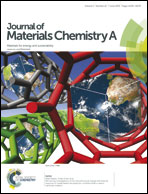Synthesis, structure and tunable shape memory properties of polytriazoles: dual-trigger temperature and repeatable shape recovery†
Abstract
Thermally induced shape memory polymers (SMPs) are capable of storage, release of energy and shape recovery on the macro-scale. In this work, cross-linked SMPs were synthesized from the monomers tris(4-(1-azido 3-oxy propan-2-ol)phenyl) methane (A3), and 1,4-bis(propargyloxy) benzene (B2), and the propargyl functionalized novolac oligomer (B3). The A3B2 polymer exhibited a low trigger temperature of 92 °C, whereas A3B3 registered a higher trigger temperature of 125° C. The extent of shape recovery of both the SMPs was above 95% and it was repeatable for at least 10 times. On repeating the shape memory cycles, the response time for shape recovery increased, but nearly a complete shape recovery was observed in both polymers. In addition, a polymer with dual trigger temperature (83 and 113 °C) was synthesized by click polymerization between the A3 monomer and stoichiometric equivalence of B2 and B3 monomers. The polytriazole networks bearing monophenyl and oligomer structures in tandem enabled both low and high trigger temperature in a single polymeric structure. The SMP possesses a shape recovery to an extent as high as 98% at both the trigger points even on the 10th shape memory cycle. These polymers exhibited hydrophobicity with a static water contact angle of about 90° and very low water absorption (<0.05 weight%). The enhanced water repellency is attributed to the inter/intra-chain hydrogen bonding characteristics of triazole bridges. The low/high/dual trigger temperature SMPs are thermally stable (T10% > 230 °C) and are suitable for actuator applications.


 Please wait while we load your content...
Please wait while we load your content...